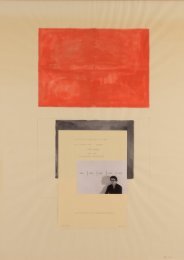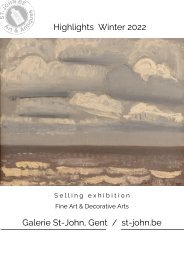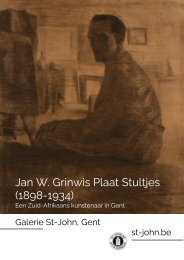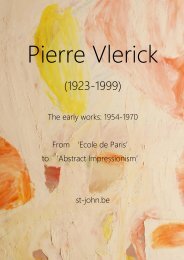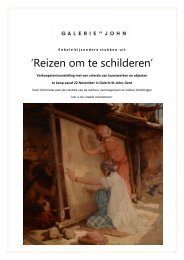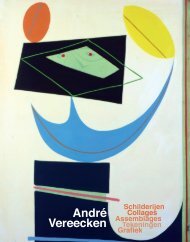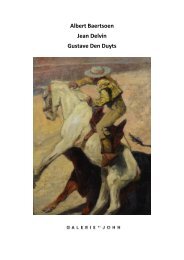Collection Wolfers & Petrucci: Hidden Treasures
Catalogue of the selling exhibition in Galerie St-John, Ghent (Belgium), exhibition from the 23rd of November to the 24th of December. 100 sculptures and (art) objects by Philippe and Marcel Wolfers, silver by Wolfers Frères, etc.
Catalogue of the selling exhibition in Galerie St-John, Ghent (Belgium), exhibition from the 23rd of November to the 24th of December. 100 sculptures and (art) objects by Philippe and Marcel Wolfers, silver by Wolfers Frères, etc.
Create successful ePaper yourself
Turn your PDF publications into a flip-book with our unique Google optimized e-Paper software.
Marcel <strong>Wolfers</strong><br />
Isis, 1919–1920<br />
Patinated oak<br />
Dimensions: 39,5 × 25,5 × 28 cm<br />
Signed: “Marcel <strong>Wolfers</strong>”, on the side of the sculpture<br />
Marked: with a brand-mark symbol of St-Georges<br />
This work is unique.<br />
Provenance:<br />
Marcel <strong>Wolfers</strong><br />
Hottat <strong>Collection</strong>, Brussels (acquired from the above<br />
in 1921 in Paris for 3000,- frcs)<br />
Marcel <strong>Wolfers</strong> and Clairette <strong>Petrucci</strong> collection<br />
(probably acquired on the sale of the Hottat<br />
collection in May 1954)<br />
Exhibited:<br />
Paris, Salon d’Automne: Les Ymagiers Belges,<br />
01/11–20/12/1921, cat. No. 2875<br />
Ghent, Design museum Gent, 16/12/2006–09/04/2007<br />
Bibliography:<br />
Adriaenssens W.; Steel R., De <strong>Wolfers</strong> Dynastie –<br />
van art nouveau tot art deco, Gent, Design museum<br />
Gent, 2006, p. 219 (with photo)<br />
The “Isis” bust was originally conceived in 1912. The bust was modelled after<br />
Yvonne <strong>Wolfers</strong> (1896–1981), daughter of Mathilde <strong>Wolfers</strong>, sister of Philippe<br />
<strong>Wolfers</strong>. The bust was a fairly realist and somewhat static portrait of Yvonne, with<br />
a reference to the goddess Isis, on a high marble pedestal. In 1919 Marcel <strong>Wolfers</strong><br />
decided to rework the bust. He tilted the head of the sitter slightly backwards,<br />
giving movement to the composition and accentuating the scarab decorated hair<br />
ornament. By starting the composition just at the height of the neck (the marble<br />
version showing the shoulders), the composition acquired better proportions.<br />
Regarding the early work of Marcel, “Isis” along with “Bilitis” are often cited as<br />
his most sensuous sculptures. Georges Verdavaine wrote in Le Home magazine:<br />
“Isis est devant nous. Regardez la pureté de son front, la sérénité de ses traits, la<br />
loyauté de son regard, la promesse de ses lèvres, où la volupté met une caresse en<br />
un sourire discret. Discrétion qui n’exclut ni la fierté, ni l’orgueil, ni la noblesse.<br />
Les cheveux s’agitent et flottent. Et la déesse apparaît, dans le charme de la<br />
séduction, comme la fille même d’une civilisation qui éclairera le monde. Isis !”<br />
The oak version was sculpted out of an<br />
ancient beam, salvaged from a construction<br />
site. It was first presented at the Salon<br />
d’Automne in Paris in 1921, where it<br />
was acquired by the very important and<br />
influential collector Albert Hottat from<br />
Brussels. When it was sold in 1954, in the<br />
sale of the collection of Hottat, Marcel<br />
<strong>Wolfers</strong> could not resist buying it back for his<br />
own collection.<br />
96




